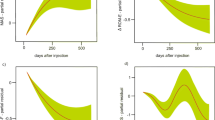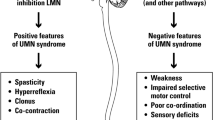Abstract
Background
Muscle weakening is a well-known side effect of muscle-tendon lengthening. Botulinum toxin A (BTX-A) weakens the muscle temporarily by blocking the neuromuscular junction. Hence application of the drug is a logical step to test whether weakness deteriorates function prior to an operation. In the present study, BTX-A application is used to test preoperatively whether the gait pattern depends on the strength of the tested muscle. Since 1999, instrumented gait analysis, including kinematic, kinetic, and dynamic electromyographic data, is routinely used to define the individual surgical program.
Methods
In our series of 110 consecutive patients with cerebral palsy (CP) considered for surgical muscle lengthening from 1999 to 2008, BTX-A was applied to identify patients at risk for functional deterioration. Gait analysis was repeated 6 weeks (maximum effect of BTX-A) and 12 weeks (follow-up) after the test injection to check for loss of joint control (excessive ankle dorsiflexion, knee flexion, increased anterior pelvic tilt).
Results
In all, 20.9% (n = 23) showed deterioration in gait after preoperative BTX-A test injections (n = 112, two patients had two test trials) in all muscles considered for lengthening. As a consequence, their lengthening surgery was canceled. A total of 68 patients underwent surgery as planned, and in none of them did gait function deteriorate. These clinical data were compared to those of a historical group (n = 105) before this test, where 18% showed functional deterioration after surgery. The similar percentage of patients filtered out by the test suggests that there could be a context to the number of poor results in the historical group.
Conclusions
We conclude that preoperative BTX-A test injection is a reliable tool for filtering out patients with risk of deterioration after muscle lengthening surgery in patients with CP and can be helpful to avoid poor outcomes.
Similar content being viewed by others
References
Koman LA, Mooney JF 3rd, Smith BP, Walker F, Leon JM. Botulinum toxin type A neuromuscular blockade in the treatment of lower extremity spasticity in cerebral palsy: a randomized, double-blind, placebo-controlled trial — BOTOX Study Group. J Pediatr Orthop 2000;20:108–115.
Molenaers G, Desloovere K, Fabry G, De Cock P. The effects of quantitative gait assessment and botulinum toxin A on musculoskeletal surgery in children with cerebral palsy. J Bone Joint Surg Am 2006;88:161–170.
Tardieu G, Thuilleux G, Tardieu C, Huet de la Tour E. Long-term effects of surgical elongation of the tendo calcaneus in the normal cat. Dev Med Child Neurol 1979;21:83–94.
Brunner R. [Muscle physiology and the effect of muscle-tendon surgery in cerebral palsy.] Orthopade 2004;33:1096–1102.
Jaspers RT, Brunner R, Baan GC, Huijing PA. Acute effects of intramuscular aponeurotomy and tenotomy on multitendoned rat EDL: indications for local adaptation of intramuscular connective tissue. Anat Rec 2002;266:123–135.
Brunner R, Jaspers RT, Pel JJ, Huijing PA. Acute and long-term effects on muscle force after intramuscular aponeurotic lengthening. Clin Orthop 2000;378:264–273.
Chang CH, Albarracin JP, Lipton GE, Miller F. Long-term follow-up of surgery for equinovarus foot deformity in children with cerebral palsy. J Pediatr Orthop 2002;22:792–799.
Chang WN, Tsirikos AI, Miller F, Lennon N, Schuyler J, Kerstetter L, et al. Distal hamstring lengthening in ambulatory children with cerebral palsy: primary versus revision procedures. Gait Posture 2004;19:298–304.
DeLuca PA, Ounpuu S, Davis RB, Walsh JH. Effect of hamstring and psoas lengthening on pelvic tilt in patients with spastic diplegic cerebral palsy. J Pediatr Orthop 1998;18:712–718.
De Morais Filho MC, Neves DL, Abreu FP, Juliano Y, Guimaraes L. Treatment of fixed knee flexion deformity and crouch gait using distal femur extension osteotomy in cerebral palsy. J Child Orthop 2008;2:37–43.
Rodda JM, Graham HK, Nattrass GR, Galea MP, Baker R, Wolfe R. Correction of severe crouch gait in patients with spastic diplegia with use of multilevel orthopaedic surgery. J Bone Joint Surg Am 2006;88:2653–2664.
Kabada MP, Ramakrishnan HK, Wootten ME. Measurement of lower extremity kinematics during level walking. J Orthop Res 1990;8:383–392.
Hermens HJ, Freriks B, Merletti R, Stegeman D, Blok J, Rau G, et al. European recommendations for surface electromyography (SENIAM). Enschede Roessingh Research and Development, CD-rom. 1999.
Heinen F. European consensus table 2006 on botulinum toxin for children with cerebral palsy. Eur J Paediatr Neurol 2006;10:215–225.
Bottos M, Benedetti MG, Salucci P, Gasparroni V, Giannini S. Botulinum toxin with and without casting in ambulant children with spastic diplegia: a clinical and functional assessment. Dev Med Child Neurol 2003;45:758–762.
Sarioglu B, Serdaroglu G, Tutuncuoglu S, Ozer EA. The use of botulinum toxin type A treatment in children with spasticity. Pediatr Neurol 2003;29:299–301.
Wong AM, Chen CL, Chen CP, Chou SW, Chung CY, Chen MJ. Clinical effects of botulinum toxin A and phenol block on gait in children with cerebral palsy. Am J Phys Med Rehabil 2004;83:284–291.
Corry IS, Cosgrove AP, Duffy CM, Taylor TC, Graham HK. Botulinum toxin A in hamstring spasticity. Gait Posture 1999;10:206–210.
Graham HK, Rodda JM. Botulinum toxin and cerebral palsy: time for reflection? Dev Med Child Neurol 2006;48:399.
Eames NW, Baker R, Hill N, Graham K, Taylor T, Cosgrove A. The effect of botulinum toxin A on gastrocnemius length: magnitude and duration of response. Dev Med Child Neurol 1999;41:226–232.
Molenaers G, Desloovere K, De Cat J, Jonkers I, De Borre L, Pauwels P, et al. Single event multilevel botulinum toxin type A treatment and surgery: similarities and differences. Eur J Neurol 2001;8(suppl. 5):88–97.
Satila H, Pietikainen T, Iisalo T, Lehtonen-Raty P, Salo M, Haataja R, et al. Botulinum toxin type A injections into the calf muscles for treatment of spastic equinus in cerebral palsy: a randomized trial comparing single and multiple injection sites. Am J Phys Med Rehabil 2008;87:386–394.
Baker R, Jasinski M, Maciag-Tymecka I, Michalowska-Mrozek J, Bonikowski M, Carr L, et al. Botulinum toxin treatment of spasticity in diplegic cerebral palsy: a randomized, double-blind, placebo-controlled, dose-ranging study. Dev Med Child Neurol 2002;44:666–675.
Robertson JV, Pradon D, Bensmail D, Fermanian C, Bussel B, Roche N. Relevance of botulinum toxin injection and nerve block of rectus femoris to kinematic and functional parameters of stiff knee gait in hemiplegic adults. Gait Posture 2009;29:108–112.
Wong AM, Pei YC, Lui TN, Chen CL, Wang CM, Chung CY. Comparison between botulinum toxin type A injection and selective posterior rhizotomy in improving gait performance in children with cerebral palsy. J Neurosurg 2005;102(suppl):385–389.
Corry IS, Cosgrove AP, Duffy CM, McNeill S, Taylor TC, Graham HK. Botulinum toxin A compared with stretching casts in the treatment of spastic equinus: a randomised prospective trial. J Pediatr Orthop 1998;18:304–311.
Detrembleur C, Lejeune TM, Renders A, Van Den Bergh PY. Botulinum toxin and short-term electrical stimulation in the treatment of equinus in cerebral palsy. Mov Disord 2002;17:162–169.
Bang MS, Chung SG, Kim SB, Kim SJ. Change of dynamic gastrocnemius and soleus muscle length after block of spastic calf muscle in cerebral palsy. Am J Phys Med Rehabil 2002;81:760–764.
Kay RM, Rethlefsen SA, Fern-Buneo A, Wren TA, Skaggs DL. Botulinum toxin as an adjunct to serial casting treatment in children with cerebral palsy. J Bone Joint Surg Am 2004;86:2377–2384.
Bassett GS, Engsberg JR, McAlister WH, Gordon JE, Schoenecer PL. Fate of the psoas muscle after open reduction for developmental dislocation of the hip (DDH). J Pediatr Orthop 1999;19: 425–432.
Author information
Authors and Affiliations
About this article
Cite this article
Rutz, E., Hofmann, E. & Brunner, R. Preoperative botulinum toxin test injections before muscle lengthening in cerebral palsy. J Orthop Sci 15, 647–653 (2010). https://doi.org/10.1007/s00776-010-1509-6
Received:
Accepted:
Published:
Issue Date:
DOI: https://doi.org/10.1007/s00776-010-1509-6




